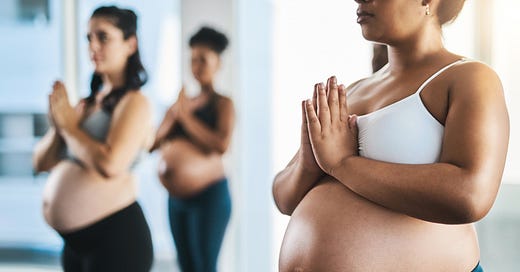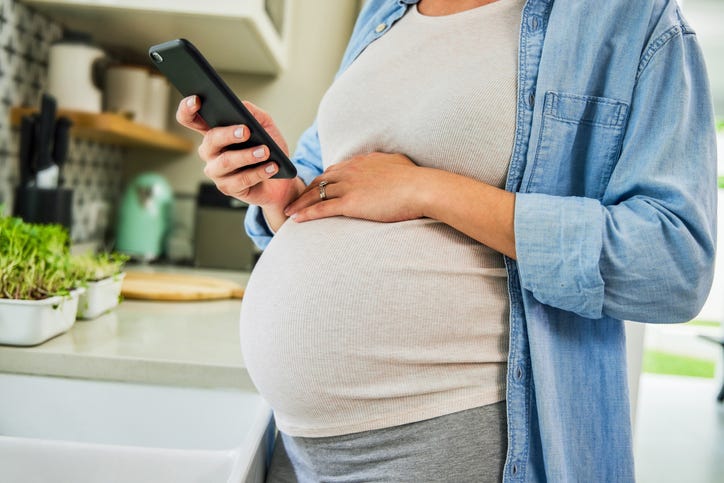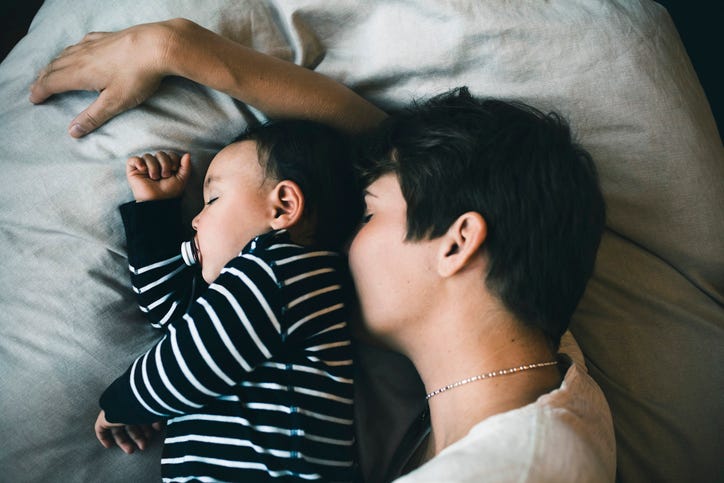Why "Building a Healthy Baby" is Bullshit
Yoga and kale will not save you in a culture that assumes we're doing pregnancy wrong.
Today I’m sharing an essay that I first wrote for Parents Magazine, midway through my second pregnancy, in 2017. The babies I wrote about are now 8 and 4, and most of the time, I no longer define my motherhood through my body in the way we do when we’re pregnant or newly post-partum. I’ve also evolved more than I thought as a writer, and rereading this piece is very much like looking at photos from my children’s first years and thinking but why did I get bangs? (If I were writing this piece today, I would absolutely discuss how these standards also cause harm by excluding children and families who don’t fit the narrow mold of what a “nuclear family” is supposed to look like.)
But I’ve heard from several readers recently who are grappling with the insane expectations of pregnancy culture, so I thought this might be a good one to revisit. You’re not alone. And none of this is your body’s fault.
Last week I also had the pleasure of discussing the particular Instagram phenomenon of pregnant ladies posing with Bump Hands1 with Kathryn Jezer-Morton, and it’s an excellent adjacent read to this one.
CW: This piece includes some discussion of a high-risk pregnancy and a medically fragile baby in intense circumstances. If that feels fraught for you right now, feel free to stop reading now.
It was Week 18 of my second pregnancy. I lay in a fake leather recliner, holding my husband’s hand and my breath, as a maternal fetal medicine specialist slid an ultrasound wand over my abdomen. This wasn’t your standard anatomy check. This doctor was trying to tell if our baby-to-be had all four chambers of her heart. And, if she would be spared the 12 surgeries, six months of hospital life and countless moments of pain and panic that our first daughter endured during her early years.
Violet was born with a rare collection of life-threatening congenital heart defects, all of which were somehow missed on the half dozen ultrasounds I had during my pregnancy with her. We didn’t know anything was wrong until her heart began shutting down when she was a month old. Violet is now a happy and healthy 4-year-old who begins every sentence with, “Actually…” But her heart condition is life-long. The question that haunted every conversation that Dan and I had about having a second child was: What if it happens again?
The odds of that were small, but much bigger than if it had never happened the first time. So my second pregnancy was immediately classified as high risk. I underwent every genetic test and screening because this doctor was determined not to miss so much as a prenatal pimple. And so, after searching the grainy images of our baby on the ultrasound monitor for about ten minutes, he turned to me with a huge smile. “Her heart is developing normally,” he said. “This baby gets an A+. Good work, Mom!”
I cried, of course. Until that moment, I didn’t trust myself to build a healthy baby heart. After all, the only other time I tried, I’d failed pretty spectacularly. That’s how it felt the day they diagnosed Violet’s heart condition. And now, with his horrible compliment, this doctor had confirmed it: If this baby was getting an A+, then that must mean I flunked the last round. Maybe I could be in the running for “Most Improved Mom?” But there were still 22 weeks of pregnancy to go. Final grades will be cumulative. Plenty of time to mess up again and let this child down as well.
I carried this failure deep inside me for the first year of Violet’s life. I was sure if I said it out loud, everyone would nod soberly and agree. Yes, we know, it was all your fault. When I finally did start to talk about it (to Dan, to my friends, to my therapist, to Violet’s doctors), instead they fell all over themselves to assure me it wasn’t true. The causes of most congenital heart defects are unknown; Violet’s were likely the result of spontaneous genetic mutations that no one could have predicted or prevented. Indeed, almost all of the “big stuff” that can go wrong during a pregnancy are caused by infinitesimally tiny tweaks in a cell’s DNA strands. These things have nothing to do with our performances as mothers or people. I get that now. And yet — that’s not how we think about it. Our culture grades pregnant women constantly: Are you meticulously taking your prenatal vitamins? Just saying no to wine and sushi? Getting enough protein, leafy greens, prenatal yoga? Good work, Mom! We talk about “building a healthy baby” as if we’re actually assembling them like so many Mr. Potato Head toys.
I did all of the above and more during my first pregnancy. I got acupuncture and prenatal massages. I counted protein grams. I only took over-priced prescription prenatal vitamins (none of those generic drug store pills for my kid!). I scrupulously avoided gas stations and nail salons, in case I inhaled too many toxic chemicals that would disrupt fetal development. I tracked my weight gain and bought organic crib sheets. Pregnancy — and then parenthood — is so scary and unknowable. I wanted to believe that if I did everything right, if I ate enough kale and chose the best diapers, I could keep my daughter safe and healthy. Perfect even, forever.
These messages about the importance of prenatal core workouts and birth plans are ostensibly about empowering women, so we feel ready and able to withstand the rigors of pregnancy, childbirth, and presumably, parenthood itself. But pretty much as soon as that line appears on the pregnancy test, they become an impossible set of standards that women use to judge each other. And there is no power there.
With Violet, I put myself through 26 hours of un-medicated labor in part because I was sure epidurals were somehow bad for my fragile baby. Fast forward to a conversation I had with her doctors after her second open-heart surgery, when we debated whether my nine-month-old needed a methadone drip to wean her off post-op fentanyl. I haven’t seen any hard science, but I’m fairly sure a few hours of epidural exposure would have nothing on those weeks of round-the-clock opiates. And yet, by then, I was the one pushing for extra doses, because it was so clear that my baby was in pain and should not be.
But if I’m being honest, the narcotic risk was only part of why I insisted on a “natural” childbirth in the first place. It was also because I wanted to prove something about how strong I was and how perfectly I could deliver a baby. I wanted an A+ delivery to match my A+ pregnancy. That wasn’t fair to my friends who had different kinds of birth experiences, whether by choice or necessity. And it wasn’t fair to myself, especially not in the final hours before I delivered, when I realized I did want the epidural after all. It was not easy, in the throes of active labor, to admit that I’d made a mistake, that apparently, I wasn’t strong enough to trust in my body’s wisdom, and I’d like some effing pain relief, please. And it really sucked when it turned out I’d gritted my teeth for too long, and now there was no time for a quick spinal injection before a brutal 90 minutes of pushing.
Here’s the worst thing about the doctor saying “this baby gets an A+!” and all of the other ways we’re told that we have to achieve perfection through pregnancy: It means that when I didn’t, it wasn’t just me that failed. Somehow, the implication is that Violet herself didn’t ace the exam because she was born with a few missing heart parts. This is also the problem with parents saying they don’t care whether it’s a boy or a girl, “as long as we have a healthy baby.” The unsaid part is that any unhealthy baby is somehow less than.
The idea that Violet is lacking in any way is hilariously wrong. She is so completely herself; this weird, sweet, curious kid who insists on sleeping in socks when it’s 90 degrees out and told me a long story this morning about a whale that had his voice stolen by a jealous fox. She is not perfect. (Or else there would be fewer mysterious marker scribbles on my walls.) But she is everything she needs to be.
Even if your baby isn’t born with a congenital defect or disability, she is, somehow, imperfect. Because she’s human. And she will get a cold, refuse to nap, tell a lie, break a heart. And then it won’t matter what grade you got on your pregnancy just like nobody asks now what my GPA was in college. We can’t stop things from going wrong for our kids, and we can’t take every sleepless night of infant colic or teenage rebellion as proof of our personal failure. Of course, if I could remove the need for extensive surgeries and frequent cardiologist visits from my daughter’s life, I would. But without whatever genetic alchemy that led to her “defects,” she wouldn’t be Violet. Her heart condition does not define her, but it is woven through her, in every cell, and in all the experiences of the last three years that have shaped who she is today. Without it, she would be some other kid. And I could never wish for that.
Our new baby, Beatrix, was born in October [2017]. And I’m grateful that she has four chambers in her heart so we won’t have to put her through so much to keep her. Yet even without heart surgery, I know there will be heartache, of some currently unknowable kind. Accepting that, as scary as it sounds, meant easing up on my pregnancy standards for myself. I went to precisely one yoga class; I had the occasional glass of wine. When I passed my glucose test, I didn’t see it as a validation of virtuous eating habits because I’d had brownies for dinner the night before. I still took prenatals every day, but the drug store brand was fine. It wasn’t a perfect pregnancy. I didn’t try to build the perfect baby. I’m just making people over here. And that’s good enough.
Reprinted with permission from Parents, ©2018, Meredith Operations Corporation. All rights reserved.
I’ve written more extensively about our experiences with a medically fragile baby in my first book, and also here.
We also talked about pregnancy and diet culture in this bonus episode.
And last week, I chatted with the fabulous Mia O’Malley about her experiences as a fat pregnant person, fat activist and momfluencer. (You can also add Burnt Toast to your podcast player: Here’s Apple Podcasts, Spotify, Stitcher, and Pocket Casts.)
I also love this series that Ragen Chastain is doing with Nicola Salmon on fat-positive fertility and gynecological care.
PS. Substack now has an app! And I was skeptical because who needs more shit on our phones, but I’ve been using it for a few weeks and I actually…love it? If you, like me, read a lot of newsletters, it’s actually quite delightful to have that clutter out of your inbox and all in one aesthetically-pleasing spot. It reminds me of everything that was great about Google Reader (RIP). New posts will never get lost in your email filters, or stuck in spam. Longer posts will never cut-off by your email app. Comments and rich media will all work seamlessly. Overall, it’s a big upgrade to the reading experience.
The Substack app is currently available only for iOS. If you don’t have an Apple device, you can join the Android waitlist here.
You’re seeing half a bump hand in the first image on this post! But it’s the lower crotch bump hand that really gets me. At no other point in life do women feel comfortable clutching our below-the-belly-button region in public. It’s as if the pregnant person is supposed to perform that they could lift the whole bump right off, like a fat suit? Anyway, read Kathryn to get the whole discussion.








As the mother of a baby born with a host of health conditions that she didn’t survive, thank you for this. Hours of therapy have helped me mostly believe it wasn’t my fault, but the culture around this is so, so toxic.
My first-born had a stroke during delivery ("even though I had a perfect pregnancy") and I almost died from a post-op (emergency c-section) blood infection. The line "as long as the baby is healthy" made -- and makes -- me want to SCREAM when I hear it. What if the baby is unhealthy? What if the birthing parent is unhealthy? Thank you seeing me. XO